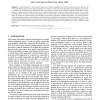Free Online Productivity Tools
i2Speak
i2Symbol
i2OCR
iTex2Img
iWeb2Print
iWeb2Shot
i2Type
iPdf2Split
iPdf2Merge
i2Bopomofo
i2Arabic
i2Style
i2Image
i2PDF
iLatex2Rtf
Sci2ools
TKDE
2010
2010
A Survey on Transfer Learning
—A major assumption in many machine learning and data mining algorithms is that the training and future data must be in the same feature space and have the same distribution. However, in many real-world applications, this assumption may not hold. For example, we sometimes have a classification task in one domain of interest, but we only have sufficient training data in another domain of interest, where the latter data may be in a different feature space or follow a different data distribution. In such cases, knowledge transfer, if done successfully, would greatly improve the performance of learning by avoiding much expensive data labeling efforts. In recent years, transfer learning has emerged as a new learning framework to address this problem. This survey focuses on categorizing and reviewing the current progress on transfer learning for classification, regression and clustering problems. In this survey, we discuss the relationship between transfer learning and other related mac...
| Added | 31 Jan 2011 |
| Updated | 31 Jan 2011 |
| Type | Journal |
| Year | 2010 |
| Where | TKDE |
| Authors | Sinno Jialin Pan, Qiang Yang |
Comments (0)

